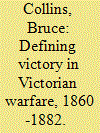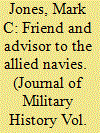|
|
|
Sort Order |
|
|
|
Items / Page
|
|
|
|
|
|
|
| Srl | Item |
| 1 |
ID:
123600


|
|
|
|
|
| Publication |
2013.
|
| Summary/Abstract |
Alexander the Great campaigned successfully for twelve years, across the range of military operations, against a wide range of opponents, and within many varied geographical environments. This article argues that this remarkable record of success can be partially attributed to Alexander's ability to adapt at the tactical, operational and strategic levels. Alexander was also capable of operating beyond the bounds of his cultural normative framework. After a brief discussion of Macedonian warfare, this article analyses Alexander's art of adaptation through the exploration of important strategic moments. These moments are his operations in the Balkans, defeat of the Persian navy, counterinsurgency in central Asia and the battle of Hydaspes.
|
|
|
|
|
|
|
|
|
|
|
|
|
|
|
|
| 2 |
ID:
123607


|
|
|
|
|
| Publication |
2013.
|
| Summary/Abstract |
During World War II, U.S. airmen circulated pernicious rumors about the motives of the hundreds of aircrews who landed in neutral countries. Although investigated and disproven by the leadership of the U.S. Army Air Forces (USAAF), the rumors persisted in popular memory and ultimately stigmatized the veterans who endured neutral captivity. This essay examines the motives of some airmen who landed in Switzerland, and argues that the stigma associated with neutral captivity resulted in denials of benefits and military decorations to deserving veterans.
|
|
|
|
|
|
|
|
|
|
|
|
|
|
|
|
| 3 |
ID:
123601


|
|
|
|
|
| Publication |
2013.
|
| Summary/Abstract |
After the Battle of Saratoga (October 1777) in the American War of Independence, British leaders conducted a comprehensive reassessment of their military strategy but examined the new strategy's ways and means without considering the ends or objectives of the war. Using extensive primary sources, this article examines the reassessment process and concludes that the effort was fatally flawed because King George III and his ministers failed to reevaluate the war's objectives, given the changed strategic environment after Saratoga. The resulting British military strategy suffered from an imbalance between ends, ways, and means. Thus, British leaders incurred significant risk in executing their new strategy.
|
|
|
|
|
|
|
|
|
|
|
|
|
|
|
|
| 4 |
ID:
123603


|
|
|
|
|
| Publication |
2013.
|
| Summary/Abstract |
The British launched numerous punitive expeditions in the decades before the international scramble for Africa. Often portrayed as 'wars against nature', such campaigns in fact posed considerable challenges, not least because they were conducted to tight deadlines and were expected to result in low-cost victories. Yet it was often difficult to define clear military objectives. This article explores punitive expeditions' demands upon their commanders and the ways in which commanders found suitable culminating points, in the absence of decisive battles, when victory might be declared and celebrated. Victory had to be defined for the intervening army, for the people and leaders of the country being attacked, and for politicians and the public at home. Defining victory was thus a complex process, reflecting the range of military, political and public pressures upon commanders.
|
|
|
|
|
|
|
|
|
|
|
|
|
|
|
|
| 5 |
ID:
123606


|
|
|
|
|
| Publication |
2013.
|
| Summary/Abstract |
The collaboration during World War II (1939-45) between the British Royal Navy (RN) and the navies-in-exile of Poland, Norway, Netherlands, Belgium, France, Yugoslavia, and Greece necessitated the creation of a liaison system between senior naval officers to ensure the effective integration of Allied navies into RN commands. This article's purpose is to explain the RN's World War II senior-level naval liaison system. It addresses the origin, duties, and evolution of the office of Principal Liaison Officer, Allied Navies (PNLO), and evaluates how the liaison office influenced the relationship between the RN and the Allied navies.
|
|
|
|
|
|
|
|
|
|
|
|
|
|
|
|
| 6 |
ID:
123604


|
|
|
|
|
| Publication |
2013.
|
| Summary/Abstract |
The Canadian Corps of 1918 was not an entirely self-made machine. It needed outside help to develop into the highly effective fighting formation that it became by war's end. Between 1914 and 1918, the British Army sent scores of officers to Canadian formations, to make up key command and staff deficiencies in the Canadian Expeditionary Force and to train selected officers to take their places. Canadian political pressure ensured that these replacements were Canadian. The product of this somewhat ad hoc mentoring process was a Canadian Corps, commanded and staffed almost entirely by Canadian officers, that could keep pace with any British Expeditionary Force formation on the Western Front.
|
|
|
|
|
|
|
|
|
|
|
|
|
|
|
|
| 7 |
ID:
123602


|
|
|
|
|
| Publication |
2013.
|
| Summary/Abstract |
In "The U.S. Army's Transition to Peace, 1865-66" Clayton R. Newell and Charles R. Shrader examine the actions taken by the Union Army in the year following the Civil War to demobilize the victorious army of more than one million volunteers; reduce the number of personnel, scale back the operations, and dispose of surplus equipment, supplies, and facilities of the various staff departments; and recruit the units of the Regular Army up to authorized strength. They then proceed to discuss the new missions assigned to the Army's administrative and supply departments, including management of the Freedmen's Bureau; caring for the disabled veterans and the fallen; and assembling the official records of the War.
|
|
|
|
|
|
|
|
|
|
|
|
|
|
|
|
| 8 |
ID:
123605


|
|
|
|
|
| Publication |
2013.
|
| Summary/Abstract |
In 1941 HMS Prince of Wales (53) journeyed from one historic episode to the next: the fight against KMS Bismarck, the first summit between Churchill and Roosevelt, convoy duty in the Mediterranean, and Force Z to the Far East, where she was sunk off the east coast of Malaya on 10 December. In addition, the Prince of Wales sailed from history-as-what-happened into history-as-public-memory. This article not only offers a portrait of an important man-of-war that has lacked a comprehensive biographical treatment; it also proposes consideration of a recurring theme-vulnerability-and follows this thread throughout this ship's history.
|
|
|
|
|
|
|
|
|
|
|
|
|
|
|
|
|
|
|
|
|